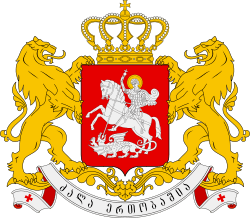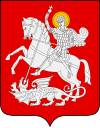Kingdom of Imereti
| Kingdom of Imereti იმერეთის სამეფო | |||||||||
|---|---|---|---|---|---|---|---|---|---|
| 1260–1810 | |||||||||
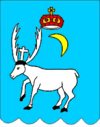 Coat of Arms
| |||||||||
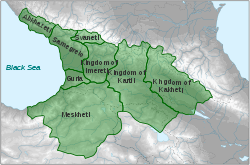 Kingdom of Imereti in 1490 | |||||||||
| Status | Kingdom, Part of Kingdom of Georgia (1330–1387, 1412–1446, 1453–1455, 1465–1478), vassal of Ottoman Empire (1555–1810), vassal of Russia (1804–1810) | ||||||||
| Capital | Kutaisi | ||||||||
| Common languages | Georgian | ||||||||
| Religion | Orthodox Christianity | ||||||||
| Government | Monarchy | ||||||||
| King | |||||||||
• 1260–1293 | David I (first) | ||||||||
• 1789–1810 | Solomon II (last) | ||||||||
| History | |||||||||
• Coronation of David I | 1260 | ||||||||
• Re-Annexation to Georgia | 1330 | ||||||||
• Restoration | 1387 | ||||||||
• Independence from Georgia | 1455 | ||||||||
• Vassal of the Ottoman Empire | May 29, 1555 | ||||||||
• Vassal of the Russian Empire | April 25, 1804 | ||||||||
• Russian Annexation | February 20 1810 | ||||||||
| |||||||||
| Today part of |
| ||||||||
| History of Georgia |
|---|
 |
|
History by topic |
|
|
The Kingdom of Imereti (Georgian: იმერეთის სამეფო) was a Georgian monarchy established in 1455 by a member of the house of Bagrationi when the Kingdom of Georgia was dissolved into rival kingdoms. Before that time, Imereti was considered a separate kingdom within the Kingdom of Georgia, to which a cadet branch of the Bagration royal family held the crown beginning in 1260 by David VI after he revolted against the Mongolian rule and fled to Abkhazia. This was due to the Mongolian conquest of the 13th century which decentralized and fragmented Georgia, forcing the relocation of governmental centers to the provinces. Imereti was conquered by Giorgi the Brilliant, who was subject to the Mongols, and united with the east Kingdom of Georgia.[1] From 1455 onward, however, the kingdom became a constant battleground between Georgian, Persian, and Turkish forces. On 25 April 1804 Solomon II of Imereti accepted Russian vassalage and in 1810 he was removed from the throne. Throughout the course of that time, Mingrelia, Abkhazia and Guria princedoms declared their independence from Imereti and became their own governments. In Persian - Azeri nomenclature the name of the region is changed to "baş açıq" which literally means "without a head scarf".[2]
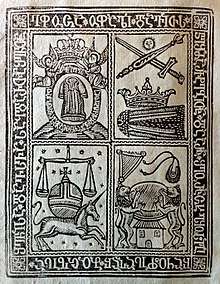
Kings of Imereti
First House of Imereti
- David I (1258–1293)
- Constantine I (1293–1326)
- Michael (1326–1329)
- Bagrat I (1329–1330)
- Vacant (1330–1387)
- Alexandre I (1387–1389)
- George I (1389–1396)
- Constantine II (1396–1401)
- Demetrius I (1401–1455), only recognized as Duke by Alexander I of Georgia
Second House of Imereti
- Demetrius II (1446–1452)
- Bagrat II (1463–1478)
- Alexander II (1478–1510)
- Bagrat III (1510–1565)
- George II (1565–1585)
- Leon (1585–1588)
- Rostom (1588–1589, 1590–1605)
- Bagrat IV (1589–1590)
- George III (1605–1639)
- Alexander III (1639–1660)
- Bagrat V (1660–1661, 1663–1668, 1669–1678, 1679–1681)
- Vakhtang Tchutchunashvili (1661–1663)[3]
- Archil (1661–63, 1678–79, 1690–91, 1695–96, 1698)
- Demetre (1663–1664)[3]
- George IV (1681–1683)[3]
- Alexander IV (1683–1690, 1691–1695)
- Simon (1699–1701)
- George V (1696–1698)[3]
- Mamia (1701–02, 1711, 1713)[3]
- George VI (1702–1707)[3]
- George VII (1707–11, 1712–13, 1713–16, 1719–1720)
- George VIII (1716)[3]
- Alexander V (1720–1741, 1741–1746, 1749–1752)
- George IX (1741)
- Mamuka (1746–1749)
- Solomon I (1752–1766, 1768–1784)
- Teimuraz (1766–1768)
- David II (1784–1789, 1790–1791)
- Solomon II (1789–1790, 1792–1810)
Heads of House of Imereti after 1815
Since Solomon II of Imereti had no sons, he proclaimed Prince Constantine, son of king David II of Imereti, and his male-line senior descendants as heirs to the throne of Kingdom of Imereti.
- Hereditary Prince Constantine (I) (1815–1844), son of king David II
- Hereditary Prince Constantine (II) (1844–1885), son of Prince Constantine (I)
- Hereditary Prince Mikheil (1885–1888), son of Prince Constantine (II)
- Hereditary Prince George (I) (1888–1932), son of Prince Mikheil
- Hereditary Prince George (II) (1932–1972), son of Prince George (I), had no issue
- Hereditary Prince Constantine (III)(1898–1978), young brother of Prince George (I)
After death of Hereditary Prince Constantine (b.1898 – d.1978), because the male-offspring of this branch came to end, the headship of the House of Bagrationi-Imereti transmitted to Prince Irakli Bagrationi (b.1925 – d.2013), son of Prince Grigol, the male-line descendant of Prince Bagrat, young brother of King Solomon I of Imereti (1752-84).
- Hereditary Prince Irakli (I) (1978–2013)
- Hereditary Prince David (2013–2017), transmitted his headship to his son
- Hereditary Prince Irakli (II) (from 2017)[4]
References
- ↑ D.M.Lang - Georgia in the Reign of Giorgi the Brilliant (1314-1346), Bulletin of the School of Oriental and African Studies, University of London, Vol. 17, pp. 74-91
- ↑ Vladimir Minorsky , La Perse au XV siècle entre la Turquie et Venice, Translation to Persian language , page 36
- 1 2 3 4 5 6 7 Non-Bagrationi monarch.
- ↑ Kings of Imereti and heirs to the throne, Official site of House of Bagrationi - Imereti
